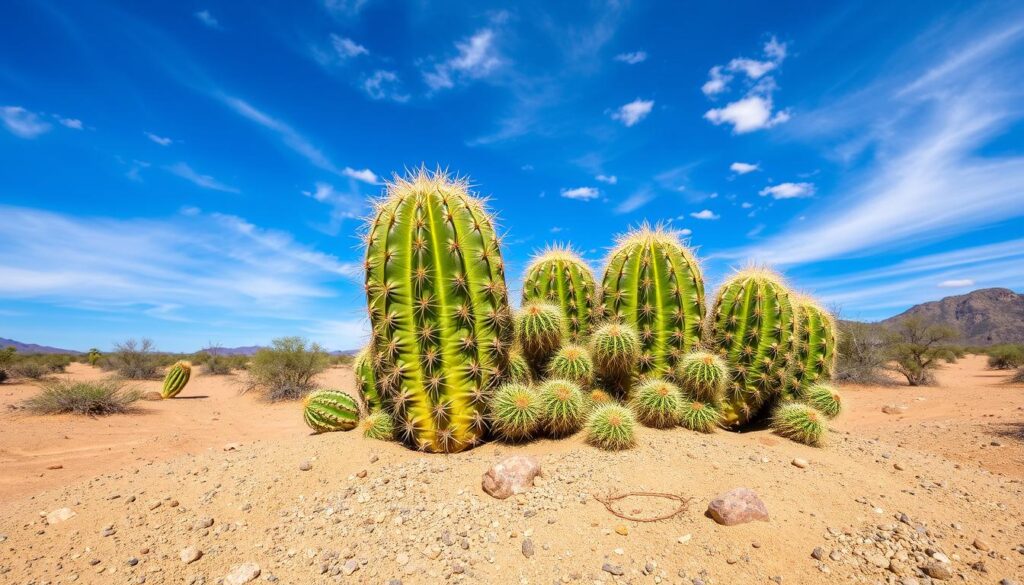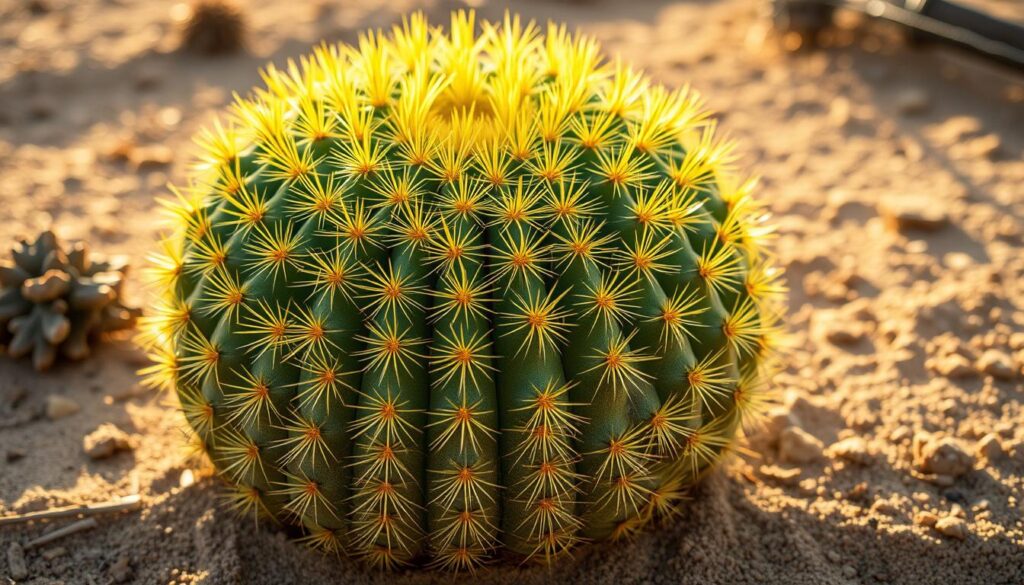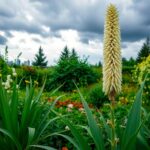Did you know that only 6% of the historical range of golden barrel cacti remains today? This fact shows how urgent it is to save these amazing desert plants. As a gardener and cactus lover, I’m thrilled to talk about Echinocactus grusonii, also known as the golden barrel cactus.
This iconic succulent comes from Mexico and can reach up to 3 feet wide. It can even live over 100 years if it’s in the right conditions. Its unique look and ability to survive in tough places make it a hit with xerophytes and cactus collectors everywhere.
Even though it’s popular in gardens, the golden barrel cactus is in big trouble in the wild. Habitat loss and illegal taking have put it at risk of disappearing. That’s why it’s crucial for us to learn about and value these tough desert plants.
Key Takeaways
- Echinocactus grusonii can live up to 100 years or more
- It’s endangered in the wild due to habitat loss and poaching
- The cactus can grow up to 3 feet in diameter
- It’s a popular choice for xeriscaping and desert gardens
- The golden barrel cactus blooms vibrant yellow flowers in summer
- It’s native to Mexico and thrives in USDA zones 9-11
- This cactus requires minimal water and full sun exposure
Introduction to Echinocactus Grusonii
I’m thrilled to introduce you to the Echinocactus grusonii, a stunning drought-tolerant plant. This golden beauty comes from Mexico and has won the hearts of those who love desert landscaping around the world.
Origin and Native Habitat
The Echinocactus grusonii, also known as the golden barrel cactus, is from Mexico’s Querétaro and Hidalgo states. It loves rich, volcanic soil and sunny slopes, living between 1,400 and 1,900 meters high. This plant is a great example of how well it can survive in dry places.
Unique Features and Characteristics
This cactus is known for its round shape and golden spines. It can grow up to 3 feet tall and wide, making it perfect for many desert landscaping styles. Its stiff yellow needles form a pattern that looks great in any garden.
Conservation Status
Unfortunately, the Echinocactus grusonii is endangered in the wild. The building of the Zimapán Dam and reservoir in the 1990s hurt its population a lot. Even though it’s endangered, it’s still popular in U.S. gardens, reminding us why we need to protect our arid plants.
As we learn more about this amazing plant, we’ll see why it’s important in drought-tolerant gardens and its role in desert ecosystems.
Botanical Classification and Taxonomy
I’ve always been drawn to the complex world of plant classification, especially southwestern plants like the Echinocactus grusonii. This golden barrel cactus is part of the Cactaceae family, along with prickly pear cactus and agave.
The Cactaceae family is quite diverse, with about 125-130 genera and 1,400-1,500 species. It’s mind-boggling to think there are around 2,000 species of cacti, each living in unique environments.
Echinocactus grusonii has a fascinating history. German plantsman Heinrich Hildmann first described it in 1891, naming it after Hermann Gruson. It was initially in the Echinocactus genus. Now, studies suggest it might be a hybrid between Echinocactus and Ferocactus.
Classifying cacti is a changing field. A 2011 study found that 61% of sampled genera in the Cactoideae subfamily weren’t monophyletic. This keeps plant enthusiasts like me excited about new discoveries!
| Characteristic | Cactaceae Family |
|---|---|
| Flower Petals/Sepals | 100% have more than ten |
| Number of Stamens | Usually hundreds |
| Energy Source | Nearly 100% use solar energy |
As I explore southwestern plants, I’m constantly amazed by their adaptations and the science behind classifying them. It shows the diversity and strength of nature in dry places.
Physical Description of the Golden Barrel Cactus
The golden barrel cactus stands out with its unique look. It’s a favorite among those who love desert plants and xerophytes. Its special features make it a standout.
Stem Structure and Growth Pattern
This cactus has a pale green stem with 21-35 deep ribs. It’s interesting to see it grow, reaching up to 90 cm tall and spreading wide. When fully grown, it can be as big as three feet in diameter and weigh over 100 pounds.
Spines and Areoles
The golden barrel cactus is known for its bright yellow spines. These spines are straight or slightly curved. They come from areoles, which change color as the plant ages. Young areoles are yellow and woolly, turning whitish, and then greyish.
Flowering Characteristics
In late spring to summer, these cacti bloom with bright yellow flowers. The flowers are 4-5 cm wide and form a ring at the plant’s top. Often, the flowers are hidden by the woolly top, adding surprise when they appear.
| Feature | Description |
|---|---|
| Height | Up to 90 cm |
| Diameter | Up to 3 feet |
| Weight | Over 100 lbs |
| Ribs | 21-35 in mature plants |
| Flower Size | 4-5 cm wide |
Habitat and Natural Environment
Echinocactus grusonii is a drought-tolerant plant that lives in central Mexico’s dry areas. I’ve seen these cacti grow on volcanic rocks and soil slopes in the Rio Moctezuma Valley. They are great for desert landscaping because they can handle tough conditions.
The golden barrel cactus faces challenges similar to plants in other famous deserts. For example, the Mojave Desert in California and Nevada gets very hot, with Death Valley once hitting 134°F (56.6°C). Like the Mojave’s plants, Echinocactus grusonii has found ways to survive.

These cacti like soil that drains well and lots of sunlight, similar to the Sonoran Desert’s plants. They’ve adapted to the desert in many ways, including:
- Waxy coatings to prevent water loss
- Spines for protection against animals
- Deep taproots for water absorption
- Specialized photosynthesis capabilities
In their natural home, Echinocactus grusonii is very important. They offer shelter and food for desert animals, helping keep the ecosystem balanced. This makes them key for desert landscaping that aims to protect nature.
| Desert | Location | Notable Feature |
|---|---|---|
| Mojave | California, Nevada, Arizona, Utah | Home to Death Valley |
| Sonoran | Mexico, Southwestern US | Habitat of Echinocactus grusonii |
| Great Victoria | Australia | Largest desert in Australia |
Desert Plants: Echinocactus Grusonii’s Role in Arid Ecosystems
I’ve always been fascinated by the resilience of southwestern plants, and Echinocactus grusonii is no exception. This golden barrel cactus plays a key role in arid ecosystems. It shows amazing adaptations to harsh desert conditions.
Adaptation to Harsh Conditions
The golden barrel cactus has evolved unique features to survive in its tough environment. Its round shape helps it lose less water in the hot desert. The golden spines offer shade and protect it from predators.
Interaction with Other Desert Flora and Fauna
In the desert, Echinocactus grusonii works with many other organisms. Its bright yellow flowers, which bloom from late spring to early summer, draw in pollinators like bats, bees, and butterflies. The cactus fruit, which ripens in late summer, is a food source for desert animals.
Ecological Importance
The golden barrel cactus is crucial to its ecosystem. It helps keep the soil stable and acts as a shelter for young plants of other desert species. This helps increase biodiversity and makes the environment more resilient.
| Desert Plant | Height | Diameter | Flowering Season |
|---|---|---|---|
| Echinocactus grusonii | Up to 5 feet | Up to 3 feet | Late spring to early summer |
| Prickly pear cactus | 3-6 feet | 4-6 feet | Spring to early summer |
| Agave | 1-20 feet | 3-6 feet | Once in lifetime |
Echinocactus grusonii lives alongside other famous southwestern plants like the prickly pear cactus and agave. Its special traits make it a vital part of the desert landscape. Its ability to adapt and survive in tough conditions amazes botanists and nature lovers.
Cultivation and Care
I enjoy growing Echinocactus grusonii in my desert landscaping. This beautiful succulent loves the sun and needs little water, ideal for xeriscaping. Its golden spines stand out against other desert plants.

To help it grow well, I plant Echinocactus grusonii in soil that drains well. It’s important not to give it too much water, as many succulents don’t like that. I water it just enough, letting the soil dry out between each watering.
This tough cactus can handle a little frost if it’s protected. In places where it gets cold, I cover it or move it inside when it gets too chilly. With the right care, it can live for over a hundred years.
“Up to 80 percent of urban water consumption in the Coachella Valley occurs outside the house.”
This fact shows how important it is to use plants that don’t need much water. Echinocactus grusonii is one such plant. It looks great with other desert plants, making a beautiful, easy-care garden that saves water.
- Requires full sun (8+ hours daily)
- Thrives in sandy, well-draining soil
- Minimal watering needed
- Tolerates heat well
- Protect from extreme cold
Echinocactus grusonii is perfect as a centerpiece in rock gardens or as an accent in modern designs. Its unique shape and golden color make it a highlight in any desert-themed garden.
Uses in Landscaping and Horticulture
Desert plants are becoming more popular for landscaping. The golden barrel cactus is a top choice for those who want drought-tolerant plants. Its unique shape and easy care make it great for many landscape designs.
Popular Ornamental Plant
The golden barrel cactus shines in desert gardens. Its round shape and golden spines make a bold statement. It’s often the main attraction in rock gardens or paired with other desert plants for a beautiful look.
Xeriscaping Applications
Xeriscaping is a landscaping method that uses less water. The golden barrel cactus fits perfectly with this approach. Desert plants like these can survive with little water, making them great for those who want to save water.
| Plant | Height | Spread | Blooming Season |
|---|---|---|---|
| Golden Barrel Cactus | 1-3 feet | 1-3 feet | Spring to Summer |
| Agave | 1-20 feet | 1-10 feet | Varies by species |
| Joshua Tree | 15-30 feet | 15-30 feet | Spring |
Indoor Cultivation Techniques
It’s possible to grow the golden barrel cactus indoors with the right care. It needs lots of sunlight and careful watering. A soil mix that drains well is key to prevent root rot. With the right care, this desert plant can be a unique addition to any room.
Propagation Methods
Propagating Echinocactus grusonii is rewarding. It’s like growing cacti and succulents. There are several ways to multiply these xerophytes, each with its own challenges and rewards.
Seed propagation is a top choice for growing diverse plants. Seeds need warmth, 70-80°F, to germinate well. The best method is the bagged approach, where seeds are in a sealed container.
Offsets are another great option for quick results. These small plants grow at the base of mature plants. Removing and rooting them can create new plants just like the parent. Make sure the cut surface forms a callus before planting to avoid rot.
Patience is crucial with Echinocactus grusonii. These cacti grow slowly. To succeed, use well-draining soil, give them plenty of light, and keep the soil moist. Even though it takes longer, the results are worth it.
FAQ
What is the origin and native habitat of Echinocactus grusonii?
What are the unique features and characteristics of this cactus?
What is the conservation status of Echinocactus grusonii?
What is the botanical classification and taxonomy of this cactus?
How does the golden barrel cactus adapt to harsh desert conditions?
What role does Echinocactus grusonii play in desert ecosystems?
How is the golden barrel cactus used in landscaping and horticulture?
How can the golden barrel cactus be propagated?
Source Links
- Golden Barrel Cactus – Echinocactus grusonii
- Golden barrel cactus: an amazing source of food for desert pollinators | One Earth
- Echinocactus grusonii
- Golden Barrel Care Guide – Learn About Golden Barrel Cacti
- Barrel cactus | Description, Facts, & Species
- Taxonomy of the Cactaceae
- Plant Ecology of the Sonoran Desert Region
- Types of Barrel Cactus – Everything You Need to Know | Planet Desert
- Desert Habitat
- Plant Adaptations – Teachers (U.S. National Park Service)
- Echinocactus grusonii | Botanico Hub
- Echinocactus Genus | Botanico Hub
- Echinocactus Grusonii — Earthpedia plant
- Top 10 Desert Plants for Your Home Garden or Landscaping Project | DBG
- Growing Plants in the Desert
- Lush & Efficient – Revised Edition
- Landscaping in the Southwest with Tina from The Desert Botanical Garden, Ep 176 – Growing Joy with Maria
- Is desert landscaping sustainable? | ASU News
- 25 Desert Plants for a Vibrant Landscape – Garden Design
- How to Propagate Cacti & Succulents – Desert Plants Of Avalon
- Four techniques for propagating your favorite succulents – Living Desert Plants


